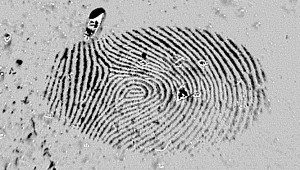
Dactyloscopy (Greek: finger show) describes the investigation of the ridges of the inner surfaces of the hand and foot. For over 100 years, it has been a recognized method for identifying individuals because according to present knowledge, the characteristics of the hand and foot prints are unique.
In historical context, different methods were used for personal identification before the fingerprints were able to prevail as an identification mark.
An important method for the identification of persons and in particular offenders was Bertillonage. Here, a system developed by Alphonse Bertillon was used according to which 11 body measurements of a person were categorized and documented. This data set was used for comparison in order to identify a person.
In the mid-19th century, fingerprints were used to identify persons for the first time. The Briton, Sir William James Herschel, introduced a system for comparing fingerprints in India in order to avoid the repeated payment of pensions and later on used the system to manage his prison. Based on the obtained large data set he was the first to suggest that fingerprints were unique and changed only slightly with age. At the same time, the British physician, Henry Faulds, discovered the uniqueness of fingerprints in Japan and suggested to use them for identifying criminals.
In the late 19th century, the Briton, Francis Galton, confirmed with his research that the ridges of the fingertips are permanent and vary a lot from person to person; this makes it possible to use them to identify persons. As a result, he developed the classification system that is used for dactyloscopy today.
Through the use of dactyloscopy, a murder case in Argentina could be solved in 1892 for the first time. Dactyloscopy was introduced as a classification and identification system in the UK in 1901 and in Germany in 1903. In France, dactyloscopy prevailed against bertillonage in 1914 after the perpetrator of the robbery of the Mona Lisa from the Louvre in 1911 could not be identified despite the fingerprints that were left at the scene.
To categorize fingerprints, they are divided into different patterns. Here, a distinction is made between vortex, bow and ribbons. This distinction makes a broad classification of fingerprints possible. The more detailed features of the fingertips, the ridges play an additional role.
The human finger tips have ridges so they can grip smooth objects. They are formed during the prenatal development in the womb (3rd to 5th month) and their development depends on environmental influences. Because of these effects, the ridges differ even with twins. The lines and fine features remain for a lifetime even after injuries and can be permanently altered only by burns or scarring.
A more detailed distinction of fingerprints is possible by comparing minutiae. A minutia is an anatomical feature of the ridges. The most common minutiae are ridge endings and the bifurcation of the lines, but other features are called minutiae as well. A large number of minutiae exists on a person’s fingers. In Germany, 12 matching characteristics on a finger are sufficient for the identification of a person in court. In the US, however, 8 matching characteristics are already sufficient for identification if the basic pattern of the fingerprints match simultaneously.
Examination of the fingerprints and the identification of individuals by comparing their fingerprints are performed by a dactyloscopy expert. These specially trained forensic scientists compare the characteristics of different fingerprints with each other and can thus determine matches, which may serve to identify a person. In Germany, the judgment of one dactyloscopy expert is sufficient to carry out an identification, while in the US, two independent dactyloscopy experts must confirm the matches.
EVISCAN helps to preserve fingerprints quickly and digitalize them with high quality pictures. This supports dactyloscopy experts to compare and identify the found fingerprints.



